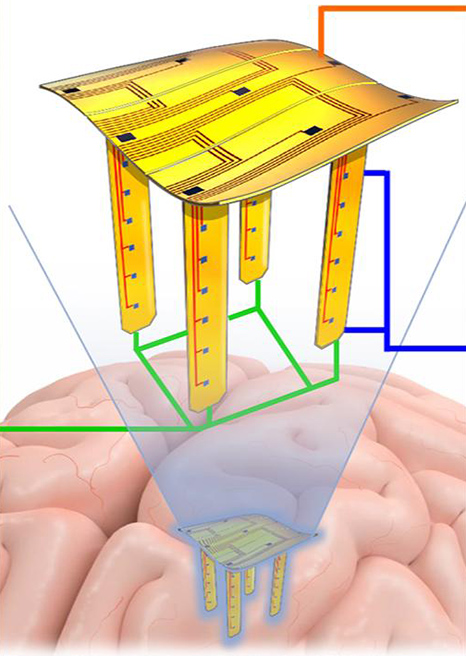Researchers at Penn State designed a pop-up electrode for brain monitoring and other applications requiring neural interfacing. The pop-up design starts life as a folded two-dimensional structure with a rigid outer coating that makes it easy to insert into the brain. Once in place, the hard coating dissolves, revealing a softer and more flexible material that is less likely to cause tissue damage. The device can unfold, like the structures in children’s pop-up books, to form a surface electrode array and four penetrating shanks that can measure signals from deeper within the neural tissue. The researchers hope that the device will help to drive advanced medical technologies, such as brain computer interfaces.
“It’s a challenge to understand the connectivity in between the large number of neuron cells within the brain,” said Huanyu Cheng, a researcher involved in the study. “In the past, people developed a device that is placed directly on the cortex to detect information on the surface layer, which is less invasive. But without inserting the device into the brain, it’s challenging to detect the intercortical information.”
While inserting electrodes into the brain itself, rather than just arranging them onto its surface, can lead to more information from deeper neural tissues, achieving a 3D perspective on how neurons interconnect would require multiple rigid probes to be placed in different areas, which can add up in terms of damage to neural tissues. This limitation prompted the researchers to develop a pop-up design in the hope that it can provide 3D connectivity data without a similar level of damage to the brain.
“To address this issue, we use the pop-up design,” said Cheng. “We can fabricate the sensor electrodes with resolution and performance comparable with the existing fabrication. But at the same time, we can pop them up into the 3D geometry before they are inserted into the brain. They are similar to the children’s pop-up books: You have the flat shape, and then you apply the compressive force. It transforms the 2D into 3D. It provides a 3D device with the performance comparable with the 2D.”
The researchers covered the device with a polyethylene glycol coating that imparts stiffness but breaks down in the brain, allowing the device to regain some flexibility. The researchers hope that the technology will assist in creating more effective and safer technologies that rely on neural interfacing.
“In addition to animal studies, some applications of the device use could be operations or treatments for diseases where you may not need to get the device out, but you’ll certainly want to make sure the device is biocompatible over a long period of time ,” said Cheng. “It is beneficial to design the structure as small, soft and porous as possible so that the brain tissue can penetrate into it and be able to use the device as a scaffold to grow up on top of that, leading to a much better recovery. We also would like to use biodegradable material that can be dissolved after use.”
Study in journal npj Flexible Electronics: Foldable three dimensional neural electrode arrays for simultaneous brain interfacing of cortical surface and intracortical multilayers
Via: Penn State
